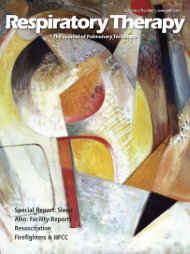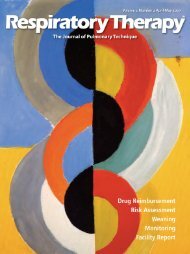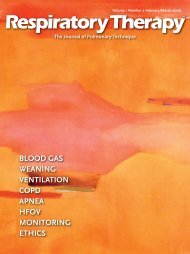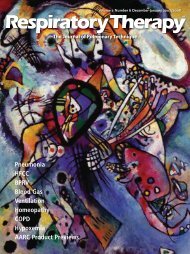RT 02-03 JJ07 main web - Respiratory Therapy Website
RT 02-03 JJ07 main web - Respiratory Therapy Website
RT 02-03 JJ07 main web - Respiratory Therapy Website
You also want an ePaper? Increase the reach of your titles
YUMPU automatically turns print PDFs into web optimized ePapers that Google loves.
at each level of applied NEP in all groups, likely to reflect a<br />
posture-related increase in the upper airway resistance. 18,23,32,33<br />
Therefore, V,NEP 0.5 and V,NEP 1 measurements appear to be<br />
influenced by the baseline expiratory upper airway resistance<br />
which has been shown to be higher in OSAH patients, probably<br />
because of minimal structural abnormalities (abnormal hyoid<br />
bone position and increase in soft pharyngeal tissues) 20 and<br />
related shape changes. It is conceivable that lower V,NEP 0.5 and<br />
V,NEP 1 found in our OSAH patients may be partly due to<br />
reduced baseline upper airway caliber which, on the other hand,<br />
is expected to increase the pharyngeal compliance and finally<br />
the upper airway collapsibility in these subjects. 21 However, the<br />
expired volume in the first 0.5 or 1 sec was lower during NEP<br />
than during the previous control expiration in either position in<br />
about 15–18% of our apneic snorers. This never occurred in<br />
snorers and controls. This fact strongly suggests that in OSAH<br />
patients a brisk narrowing of upper airways is elicited by the<br />
sudden NEP application, the magnitude of which is largely<br />
depending on the pharyngeal collapsibility under the prevailing<br />
circumstances and substantially reflected by the V,NEP 0.5 or<br />
V,NEP 1 values. In line with this reasoning, the early expiratory<br />
flow during NEP was often below the isovolume spontaneous<br />
expiratory flow, particularly in OSAH patients (see Fig. 1), as<br />
also shown in previous studies. 22,27,28<br />
Under these experimental conditions, V,NEP 0.5 was significantly<br />
lower in apneic than in non-apneic snorers when measured in<br />
the supine position utilizing the smallest level of NEP (i.e.: -5<br />
cmH 2O in our study). Thus, the lower the value of V,NEP 0.5 (or<br />
V,NEP 1), the higher the possibility for snoring people to have<br />
OSAH. Indeed, according to this method an increased<br />
pharyngeal collapsibility even during wakefulness affects the<br />
vast majority of snorers who have OSAH. This information is<br />
obtained in a rapid, simple and non-invasive way without<br />
cooperation of the subjects who can be studied when awake,<br />
repeatedly and in different body position. In this respect it has<br />
to be stressed that it is not necessary to control with regards to<br />
baseline spontaneous tidal volumes and flows. Indeed, ΔV,NEP 0.5<br />
and ΔV,NEP 1 did not perform differently or better to distinguish<br />
between snorers and OSAH patients than V,NEP 0.5 and V,NEP 1.<br />
Unfortunately, the ability to differentiate snorers with or<br />
without OSAH was not sufficient, at least within our capabilities,<br />
to recommend this technique and related parameters as a<br />
reliable diagnostic tool to obviate sleep studies or even to select<br />
subjects for polysomnographic evaluation. Lower levels of NEP<br />
(i.e.: -2 or -3 cmH 2O), however, might be more useful for this<br />
purpose and deserve to be tested in the future.<br />
Three further comments need to be made. Firstly, generally a<br />
high collapsibility of the upper airways does not seem sufficient<br />
to cause OSAH since several snorers without OSAH exhibited<br />
similarly reduced values of V,NEP 0.5 or V,NEP 1. Secondly, other<br />
factors must influence the severity of OSAH, as assessed by ODI<br />
and AHI, because no different values of V,NEP 0.5 (or V,NEP 1)<br />
were found in any position or with different levels of NEP<br />
between mild-to-moderate and severe OSAH patients. Thirdly,<br />
some OSAH patients have surprisingly high values of V,NEP 0.5<br />
(or V,NEP 1) comparable to those of the controls, showing a<br />
normal upper airway collapsibility during wakefulness, and thus<br />
suggesting different state-related factors leading to OSAH or a<br />
site of upper airway obstruction during sleep only at nasopharyngeal<br />
level which cannot be directly assessed with this<br />
technique.<br />
Finally, contrary to the opinion of the other authors who used<br />
the NEP technique to detect OSAH patients during<br />
wakefulness, 27-30 we have to stress that, although the results<br />
obtained with V,NEP 0.5 were similar or even better than the<br />
previous ones, 27-30 whatever NEP-related parameter is adopted,<br />
presently this tool is not sufficiently capable of revealing OSAH<br />
on an individual basis for clinical purpose.<br />
In conclusion, the NEP technique when properly used is<br />
potentially useful to study upper airway collapsibility in patients<br />
with OSAH during wakefulness in order to better understand its<br />
<strong>main</strong> mechanisms, to assess in the long term the effects of<br />
various interventions, and possibly for selecting non-apneic<br />
snorers to follow up. On the other hand, it cannot be<br />
recommended for routine OSAH screening in awake snorers<br />
who should subsequently be subjected to sleep studies.<br />
References<br />
1 Isono S, Saeki N, Tanaka A, Nishino T: Collapsibility of<br />
passive pharynx in patients with acromegaly. Am J Respir<br />
Crit Care Med 1999, 160:64-68.<br />
2 Isono S, Tanaka A, Sho Y, Konno A, Nishino T: Advancement<br />
of the mandible improves velopharyngeal airway patency. J<br />
Appl Physiol 1995, 79:2132-2138.<br />
3 Isono S, Remmers JE, Tanaka A, Sho Y, Sato J, Nishino T:<br />
Anatomy of pharynx in patients with obstructive sleep apnea<br />
and in normal subjects. J Appl Physiol 1997, 82:1319-1326.<br />
4 Isono S, Shimada A, Utsugi M, Konno A, Nishino T:<br />
Comparison of static mechanical properties of the passive<br />
pharynx between normal children and children with sleepdisordered<br />
breathing. Am J Respir Crit Care Med 1998,<br />
157:1204-1212.<br />
5 Liistro G, Stanescu D, Dooms G, Veriter C, Aubert-Tulkens<br />
G, Rodenstein D: Hypopharyngeal and neck cross-sectional<br />
changes monitored by inductive plethysmography. J Appl<br />
Physiol 1990, 68:2649-2655.<br />
6 Brown IG, Bradley TD, Phillipson EA, Zamel N, Hoffstein V:<br />
Pharyngeal compliance in snoring subjects with and without<br />
obstructive sleep apnea. Am Rev Respir Dis 1985, 132:211-<br />
215.<br />
7 Schwab RJ, Gefter WB, Hoffman EA, Gupta KB, Pack AI:<br />
Dynamic upper airway imaging during awake respiration in<br />
normal subjects and patients with sleep disordered<br />
breathing. Am Rev Respir Dis 1993, 74:1385-1400.<br />
8 Schwab RJ, Gefter WB, Pack AI, Hoffman EA: Dynamic<br />
imaging of the upper airway during respiration in normal<br />
subjects. J Appl Physiol 1993, 74:1504-1514.<br />
9 Gleadhill IC, Schwartz AR, Schubert N, Wise RA, Permutt S,<br />
Smith PL: Upper airway collapsibility in snorers and in<br />
patients with obstructive hyperpnea and apnea. Am Rev<br />
Respir Dis 1992, 143:1300-13<strong>03</strong>.<br />
10 Smith PL, Wise RA, Gold AR, Schwartz AR, Permutt S: Upper<br />
airway pressure-flow relationships in obstructive sleep<br />
apnea. J Appl Physiol 1988, 64:789-795.<br />
11 Schwartz AR, Smith PL, Wise RA, Gold AR, Permutt S:<br />
Induction of upper airway occlusion in sleeping individuals<br />
with subatmospheric nasal pressure. J Appl Physiol 1988,<br />
64:535-542.<br />
12 Schwab RJ, Gupta KB, Gefter WB, Metzeger LJ, Hoffman EA,<br />
Pack AI: Upper airway and soft tissue anatomy in normal<br />
subjects and patients with sleep disordered breathing.<br />
Significance of lateral pharyngeal walls. Am J Respir Crit<br />
Care Med 1995, 152:1673-1689.<br />
13 Watanabe T, Isono S, Tanaka A, Tanzawa H, Nishino T:<br />
<strong>Respiratory</strong> <strong>Therapy</strong> Vol. 2 No. 3 � June-July 2007 69











